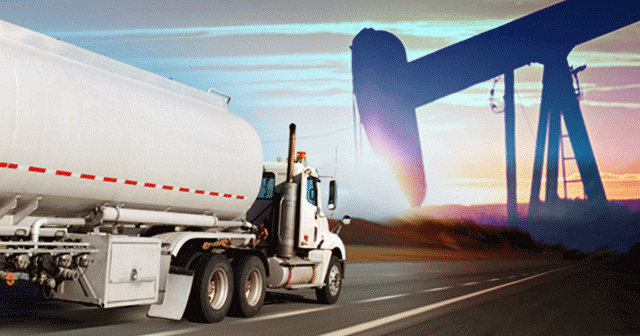What Is Meant by Upstream and Downstream Supply Chain?

The difference between upstream oil production and downstream refined fuels delivery is important.
If your company is only concerned with downstream operations, do you need to understand the entire supply chain fully? Yes!
You know that your processes do not exist in a vacuum. The actions in upstream oil and gas ripple throughout the industry and affect downstream refined fuel production.
DTN believes that the best decisions are data-driven. Refined Fuels Demand provides operational intelligence to take the overall market and demand data and create actionable insights.
This article will consider upstream and downstream oil and gas and note how each portion interacts with the other and what it means for you.
Oil and gas supply chain
Many parts comprise the journey by which oil is drilled from the earth and ends up as a usable product like gasoline. Broadly, those parts involve three main categories: upstream, midstream, and downstream.
Upstream and downstream sectors of the petroleum industry are often-misunderstood concepts. An upstream company will search for raw materials and produce them by extracting them from the earth using drilling rigs. In contrast, a downstream company will refine these natural resources into usable products like gasoline.
Some companies handle both upstream and downstream operations and are referred to as integrated oil and gas companies. Other companies that solely manage one will be designated either an upstream, midstream, or downstream company.
Upstream oil and gas
When the average layperson thinks about the oil and gas industry, the upstream processes are what they usually picture. The upstream segment of the oil and gas industry is responsible for finding, producing, and transporting crude oil. It includes exploration, drilling, and extraction.
Exploration refers to the work done by geologists and other experts to locate oil sources. From there, wells are drilled and will involve related companies such as rig operations and machinery providers. Finally, crude oil is brought to the surface using a process called extraction or production.
Midstream oil and gas
Midstream operations are exactly what they sound like – a midpoint between upstream and downstream. This midpoint can include storage facilities of crude oil and natural gas and provide transportation of crude oil or natural gas through means such as trucks and pipelines.
The midstream process is essential. There is usually a delay between production and delivery, so having safe and suitable storage for crude oil in the meantime is a must.
Downstream oil and gas
The downstream division covers three main areas of the production process: refinement, marketing, and distribution. Petrochemical plants, natural gas distributors, retail outlets, oil refineries, and petroleum product merchants are typical downstream companies located at the supply chain’s end.
During the refinement process, crude oil is turned into various products that companies can bring to market. Naturally, you think of gasoline, diesel, and heating oil. In addition, however, refineries can use crude oil to make many other products, such as plastics, asphalt, and more.
Crude oil is refined using the following process:
- Crude oil is funneled through hot furnaces that separate the liquids and vapors into distillation units. There, they are further divided into fractions depending on those components’ individual boiling points.
- Next is conversion, or cracking. This part of the process uses heat and pressure to convert heavy hydrocarbon molecules into lighter ones.
- A refinery will create a finished product, such as gasoline, by combining different hydrocarbon streams during the treatment phase.
Next, the wholesale and retail products are marketed to business, industry, government, and public consumers. Finally, once those refined fuels have been sold, it’s time for distribution! Downstream distributors deliver the finished product.
The closer the downstream operation is to a finished retail product for a consumer, the farther downstream it is considered to be.
Interactions between the upstream and downstream supply chains
As mentioned, oil’s journey from a drilling rig to a gas pump is a continuous one. Events that impact the upstream production of crude oil also impact downstream operations. The following discusses two areas that impact all segments of the supply chain: pricing and demand interruptions.
Pricing
Pricing is essential for downstream operations. Therefore, it is vital to understand all of the factors that impact your price. Consider how upstream and downstream operations view the price of crude oil differently.
For upstream operations, the price of crude oil represents income. Therefore, rising prices mean higher revenue.
For downstream operations, the price of crude oil is an expense. Therefore, the higher the price of crude oil, the smaller a downstream company’s profit margin will be, and the inverse is also true.
Of course, it is crucial to be aware of trends that will affect your profit margins in any business. This awareness will impact how money is spent throughout the business, from hiring to marketing. For downstream operations, correctly pricing your inventory is incredibly important, and you want to know how you can maximize long/short market opportunities.
Supply interruptions
There are various reasons for reductions in your crude oil supply. For example, natural disasters may slow down the refinement of crude oil. For downstream supply partners, this means that the demand will greatly outweigh the supply of gasoline and other products. Knowing this will affect your inventory pricing.
Inventory management plays a role in maximizing profit-making opportunities. Knowing what trends are happening in all areas of the industry gives you the insight to make smarter business decisions. By putting the right product in the right markets at the right time, you can increase your overall profitability.
The complete picture
At DTN, we believe that you make the best decisions when using the best data. By processing nearly 85% of all refined fuel lifts in the United States, DTN has a clear view of what is happening within the industry.
Our position within the markets allows us to leverage meaningful location-specific operating statistics. In addition, our multi-dimensional infrastructure model provides an unrivaled, analytical look at demand activity.
Make your decisions using the finest business intelligence on the market. Be confident in your choices, knowing they were made without manual reporting bias or human error concerns. Our comprehensive data feed will be customized to your specific needs and location.
Contact us today to add Refined Fuels Demand and get a clear view of where, when, and how much fuel demand fluctuations will impact your business.










 Comprehensive weather insights help safeguard your operations and drive confident decisions to make everyday mining operations as safe and efficient as possible.
Comprehensive weather insights help safeguard your operations and drive confident decisions to make everyday mining operations as safe and efficient as possible. Learn how to optimize operations with credible weather and environmental intelligence. From aviation safety to environmental compliance, our comprehensive suite of solutions delivers real-time insights, advanced forecasting, and precise monitoring capabilities.
Learn how to optimize operations with credible weather and environmental intelligence. From aviation safety to environmental compliance, our comprehensive suite of solutions delivers real-time insights, advanced forecasting, and precise monitoring capabilities.